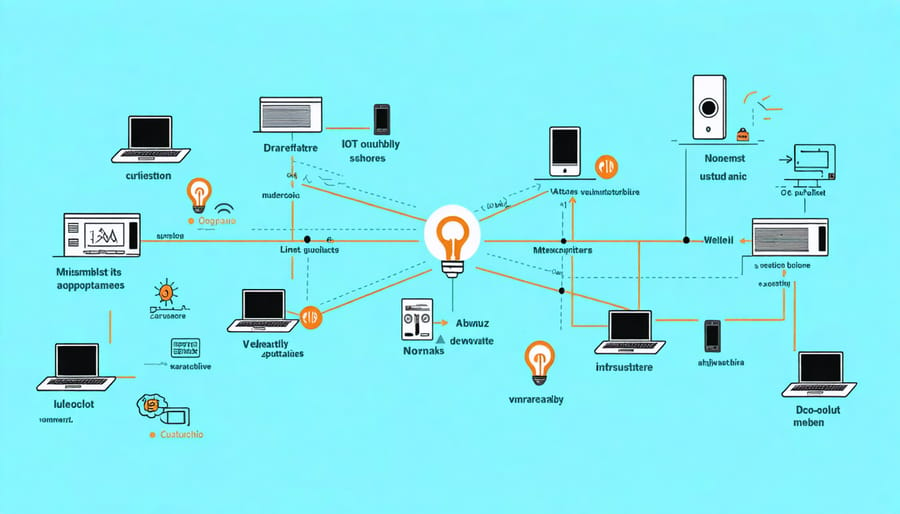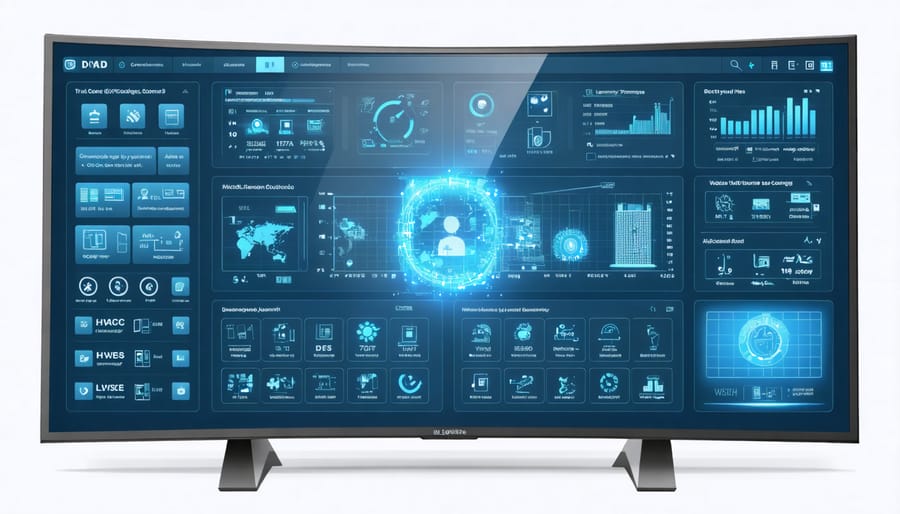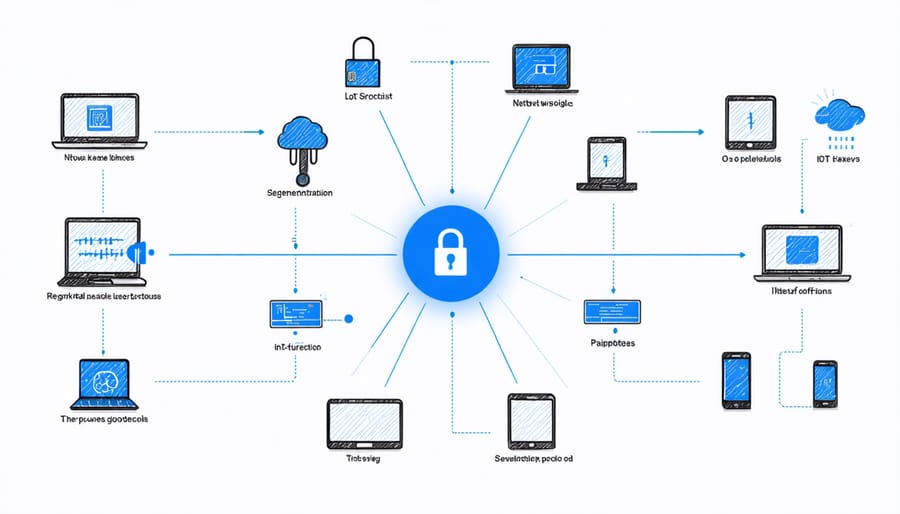The rapid integration of IoT devices into modern construction and facility management has created unprecedented security vulnerabilities that demand immediate attention. From smart HVAC systems to automated access controls, each connected device represents a potential entry point for cybercriminals targeting critical infrastructure. Recent industry data reveals that 87% of construction firms experienced IoT-related security breaches in 2023, with an average cost of $3.1 million per incident.
The stakes are particularly high in the construction sector, where compromised building management systems can lead to catastrophic failures, data breaches, and severe operational disruptions. Smart sensors monitoring structural integrity, automated material handling systems, and connected safety equipment now form the backbone of modern construction operations – yet many remain dangerously exposed to cyber threats.
As construction technology continues to evolve, the intersection of physical infrastructure and digital systems creates complex security challenges that traditional IT approaches fail to address. Project managers and facility operators must understand that securing IoT devices is no longer optional – it’s a fundamental requirement for protecting assets, ensuring occupant safety, and maintaining regulatory compliance in today’s interconnected building environments.
The Expanding Attack Surface in Smart Infrastructure

Common Entry Points for Cyber Attacks
IoT devices in construction and infrastructure projects often present multiple entry points for cyber attacks, primarily due to inadequate security measures during implementation. These vulnerabilities extend beyond basic network vulnerabilities in infrastructure to include specific weaknesses in device configuration and deployment practices.
Common entry points include default passwords that remain unchanged, unsecured communication protocols, and outdated firmware lacking critical security patches. Building automation systems, particularly those controlling HVAC, lighting, and access control, are frequently targeted through these vulnerabilities. Unauthorized access often occurs through poorly configured remote access features, unencrypted data transmission, and insufficient authentication mechanisms.
Recent security assessments have identified that many IoT sensors and monitoring devices in construction sites operate on legacy systems that weren’t designed with modern cybersecurity requirements in mind. These devices frequently lack robust encryption capabilities and secure update mechanisms, making them susceptible to man-in-the-middle attacks and unauthorized firmware modifications.
Real-world Security Breaches
Several high-profile IoT security breaches in construction and infrastructure projects serve as stark reminders of the vulnerabilities these systems face. In 2017, a prominent European smart building project experienced a significant breach when hackers gained access to its building management system through unsecured IoT sensors. The attackers manipulated HVAC controls and security cameras across multiple floors, causing operational disruptions and raising serious privacy concerns.
Another notable incident occurred in 2019 when a major U.S. construction firm’s network of IoT-enabled equipment was compromised. Unauthorized access to connected cranes and material tracking systems led to project delays and potential safety risks. The breach was traced to inadequately secured IoT devices using default passwords.
In 2021, a smart city infrastructure project in Asia faced a sophisticated cyber attack targeting its traffic management system. Hackers exploited vulnerabilities in IoT traffic sensors and controllers, causing traffic signal malfunctions across the city. The incident highlighted the critical importance of robust security protocols in urban infrastructure projects.
These cases underscore the necessity for comprehensive IoT security measures in construction and infrastructure implementations, particularly during the initial planning and deployment phases.
Critical Vulnerabilities in Building Management Systems

HVAC and Access Control Risks
Connected HVAC systems and electronic access controls represent critical vulnerabilities in modern smart buildings. Recent security assessments have revealed that these systems, when compromised, can provide attackers with significant control over building operations and occupant safety. A notable case study from a commercial high-rise in Chicago demonstrated how unsecured HVAC networks could be exploited to manipulate temperature controls and access sensitive building data.
Building automation systems (BAS) increasingly rely on IoT connectivity for efficient operation, but this integration creates potential entry points for cyber threats. Security researchers have documented instances where compromised access control systems allowed unauthorized entry by exploiting weak authentication protocols and outdated firmware. These vulnerabilities can be particularly devastating when combined with other infrastructure risk management solutions that may also be compromised.
To mitigate these risks, facility managers should implement:
– Regular security audits of HVAC and access control systems
– Network segmentation to isolate building automation systems
– Strong encryption for all IoT device communications
– Continuous monitoring of system activities
– Prompt firmware updates and patch management
Industry experts recommend developing comprehensive incident response plans specifically addressing HVAC and access control breaches. This should include procedures for manual override capabilities and emergency protocols for system restoration. Regular staff training on security awareness and proper system operation remains essential for maintaining building security integrity.
Data Privacy Concerns
The proliferation of IoT devices in modern construction projects raises significant data privacy concerns that industry professionals must address. These smart devices continuously collect vast amounts of sensitive information, including building occupancy patterns, energy usage data, security system logs, and environmental measurements. Without proper safeguards, this data becomes vulnerable to unauthorized access and exploitation.
Construction firms must carefully consider how IoT devices store and transmit data across their networks. Many IoT sensors and monitoring systems collect personally identifiable information (PII) about building occupants, employees, and visitors. This includes access control data, surveillance footage, and workplace activity patterns. The storage and processing of such sensitive information must comply with data protection regulations like GDPR and industry-specific standards.
A particular challenge lies in the long-term data retention practices of IoT systems. Construction projects often implement devices that will remain operational for decades, necessitating careful consideration of data lifecycle management. Organizations must establish clear policies regarding data encryption, storage duration, access controls, and secure disposal methods.
Third-party vendors and cloud service providers introduce additional privacy risks. When IoT devices transmit data to external servers, construction firms must ensure proper data handling agreements are in place and verify that service providers maintain adequate security measures. Regular privacy impact assessments and data protection audits should be conducted to identify and mitigate potential vulnerabilities in the IoT ecosystem.
Security Solutions for Infrastructure IoT

Network Segmentation Strategies
Network segmentation is a critical security strategy for IoT implementations in construction environments, particularly when dealing with interconnected building systems and smart infrastructure. By dividing networks into distinct segments, organizations can better control access, contain potential security breaches, and protect sensitive operational data.
A robust segmentation strategy typically involves creating separate network zones for different types of IoT devices based on their functions and security requirements. For instance, building automation systems should operate on a different network segment than guest Wi-Fi networks or administrative systems. This separation helps prevent unauthorized access and limits the potential spread of security threats.
Implementation of Virtual LANs (VLANs) and firewalls between segments provides additional security layers. Critical systems like access control and surveillance should operate on isolated networks with strict access controls and monitoring protocols. Similarly, IoT sensors for environmental monitoring or energy management should be segregated from networks handling sensitive project data or financial information.
Best practices for network segmentation in construction IoT include:
– Implementing micro-segmentation for granular control over device communication
– Establishing dedicated management networks for IoT device configuration
– Using network access control (NAC) solutions to authenticate devices
– Regular security audits of network segments and access policies
– Maintaining detailed documentation of network architecture and segmentation rules
For large construction sites or facilities, consider implementing a zero-trust architecture where all devices must authenticate regardless of their network location. This approach ensures that even if one segment is compromised, other critical systems remain protected.
Real-world examples demonstrate that properly segmented networks can significantly reduce the impact of security incidents and improve overall system reliability in smart building implementations.
Authentication and Encryption Protocols
In the construction and infrastructure sector, implementing robust authentication and encryption protocols for IoT devices is crucial for maintaining secure operations. Modern building management systems rely heavily on interconnected sensors and control devices, making strong security measures essential. Two-factor authentication (2FA) has become a standard requirement for IoT device access, particularly in critical infrastructure applications.
Advanced encryption methods, including Transport Layer Security (TLS) 1.3 and secure boot mechanisms, provide foundational protection against unauthorized access and data breaches. These protocols ensure that device-to-device communication remains confidential and tamper-proof, which is vital for maintaining the integrity of building automation systems.
The integration of AI-powered security measures has enhanced the capability to detect and respond to potential security threats in real-time. These systems can identify unusual patterns in device behavior and automatically implement protective measures before breaches occur.
Modern IoT deployments in construction projects benefit from cryptographic protection systems that utilize hardware security modules (HSMs) for key management. This approach ensures that even if one device is compromised, the entire network remains secure through compartmentalization and zero-trust architecture principles.
Industry best practices now mandate regular security audits and firmware updates for all IoT devices in building systems. This includes implementing role-based access control (RBAC) and maintaining detailed logs of all device interactions, ensuring accountability and traceability in security-critical environments. These measures are particularly important for systems controlling essential building functions such as HVAC, lighting, and access control.
Regular Security Audits
Regular security audits form the backbone of a robust IoT security strategy in construction environments. These systematic assessments help identify vulnerabilities, ensure compliance with industry standards, and maintain the integrity of connected building systems. According to recent industry data, organizations conducting quarterly security audits experience 63% fewer security breaches compared to those performing annual reviews.
For construction projects implementing IoT solutions, security audits should encompass several critical components. These include network infrastructure assessment, device firmware verification, access control systems evaluation, and data encryption protocols review. The audit process should also examine the integration points between various IoT devices and building management systems to identify potential security gaps.
Leading construction firms have adopted a three-tier audit approach:
1. Physical security assessment of IoT devices and their deployment locations
2. Network security evaluation, including wireless protocols and communication channels
3. Software and firmware security verification, including update mechanisms and patch management
A comprehensive security audit should be conducted at least quarterly, with additional assessments following any significant system changes or upgrades. This frequency ensures that new vulnerabilities are quickly identified and addressed before they can be exploited. Construction managers should maintain detailed documentation of each audit, including findings, remediation actions, and follow-up verification.
Real-world implementation has shown that automated audit tools, combined with manual expert assessment, provide the most effective results. These tools can continuously monitor system behavior, flag unusual patterns, and generate detailed reports for security teams to analyze. However, human expertise remains crucial for interpreting results and making strategic security decisions.
Best practices for IoT security audits in construction include:
– Establishing clear audit protocols and schedules
– Maintaining an up-to-date inventory of all IoT devices
– Documenting all system changes and updates
– Implementing automated monitoring tools
– Conducting regular staff training on security procedures
– Creating incident response plans based on audit findings
The rapid adoption of IoT devices in construction and facility management brings transformative benefits, but as our analysis has shown, it also introduces significant security challenges that cannot be ignored. The vulnerabilities we’ve examined – from weak authentication protocols to insecure data transmission and inadequate firmware updates – represent real threats to construction projects and operational infrastructure.
Looking ahead, the IoT security landscape will continue to evolve as threat actors develop more sophisticated attack methods. However, the construction industry is responding with enhanced security frameworks and improved standards. The development of AI-powered security solutions, blockchain integration for device authentication, and advanced encryption protocols shows promise in addressing current vulnerabilities.
Industry stakeholders must prioritize a comprehensive security approach that combines technical solutions with robust organizational policies. This includes implementing regular security audits, maintaining strict device management protocols, and ensuring continuous employee training on cybersecurity best practices. The success of IoT implementation in construction projects will largely depend on how well organizations balance innovation with security considerations.
Several key recommendations emerge from our analysis:
– Establish comprehensive IoT security policies before deployment
– Implement multi-layer security protocols for all connected devices
– Regularly update and patch all IoT systems
– Conduct periodic security assessments
– Maintain detailed documentation of all IoT assets
– Invest in employee cybersecurity training
The future of IoT in construction remains promising, but success depends on proactive security measures. As regulatory frameworks mature and security technologies advance, organizations must stay informed and adaptable. Those who implement robust security strategies while leveraging IoT capabilities will be best positioned to realize the full potential of connected construction technologies while minimizing associated risks.
The path forward requires vigilance, collaboration among industry stakeholders, and a commitment to security as a fundamental aspect of IoT implementation. By maintaining this focus, the construction industry can continue to innovate while protecting its critical infrastructure and data assets.

